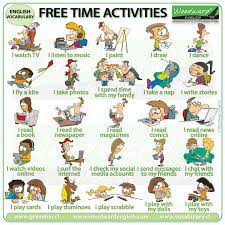
Unlocking the Power of Activities: Fun-filled Learning and Growth for Children
Activities: The Key to Fun and Learning for Kids
Engaging in activities is not only a source of entertainment for children but also a powerful tool for their growth and development. Whether it’s physical, cognitive, or social activities, they all play a crucial role in shaping a child’s overall well-being. Let’s dive into the importance of activities and how they contribute to a child’s learning journey.
Physical activities are vital for children’s health and physical development. Running, jumping, climbing, and playing sports not only keep them active but also help in building strong bones and muscles. These activities improve coordination, balance, and motor skills while promoting an active lifestyle from an early age.
Cognitive activities stimulate the mind and enhance intellectual abilities. Puzzles, board games, reading books, and engaging in educational apps or online platforms are excellent ways to challenge children’s thinking skills. These activities encourage problem-solving, critical thinking, creativity, and improve memory retention.
Social activities provide opportunities for children to interact with their peers and develop important social skills. Participating in team sports or group projects fosters teamwork, communication skills, empathy, and cooperation. It helps children understand the value of collaboration while building lasting friendships along the way.
Outdoor activities offer a breath of fresh air and expose children to nature. Exploring parks, going on nature walks or hikes promotes an appreciation for the environment while providing sensory experiences that stimulate curiosity. Outdoor play also improves mental well-being by reducing stress levels and increasing Vitamin D intake.
Creative activities allow children to express themselves through art forms such as drawing, painting, sculpting or crafting. Engaging in creative pursuits boosts imagination, self-expression and provides an outlet for emotions. It encourages children to think outside the box while developing fine motor skills.
It is important to strike a balance between structured activities with clear objectives and unstructured playtime where children have the freedom to explore their interests independently. Both types of activities contribute to a child’s holistic development and help them discover their passions and talents.
Parents and caregivers play a crucial role in encouraging and facilitating various activities for children. They can provide the necessary resources, guidance, and support to ensure that children have ample opportunities to engage in diverse activities. By actively participating in activities with their children, parents can also strengthen the parent-child bond.
Schools and educational institutions also play a vital role in promoting a wide range of activities. By incorporating extracurricular activities into the curriculum, schools provide students with a platform to explore their interests beyond academics. These activities foster well-rounded individuals who are equipped with essential life skills.
In conclusion, activities are not just a way to pass the time; they are essential for a child’s growth and development. From physical fitness to cognitive stimulation, social interaction, outdoor exploration, and creative expression – each activity brings its own set of benefits. So let’s encourage our children to embrace various activities and create an environment where they can learn while having fun!
Commonly Asked Questions About Activities in English (UK)
- What are some types of activities?
- What is the synonym of activities?
- What kind of activities are fun?
- What is activity example?
- What are good ideas for activities?
- What are simple activities?
What are some types of activities?
There are numerous types of activities that children can engage in to promote their physical, cognitive, and social development. Here are some examples:
- Physical Activities: These include sports such as football, basketball, swimming, dancing, martial arts, cycling, or simply playing tag in the park. Physical activities help children develop coordination, balance, strength, and overall fitness.
- Cognitive Activities: These activities stimulate the mind and promote intellectual growth. Examples include puzzles, board games, reading books, solving riddles or brainteasers, building with blocks or Legos, experimenting with science kits, or engaging in educational apps or online platforms.
- Social Activities: These activities focus on developing social skills and building relationships with others. They include team sports like soccer or basketball, joining clubs or organizations at school such as drama club or chess club, participating in group projects or community service activities.
- Outdoor Activities: These activities take place in nature and provide opportunities for exploration and sensory experiences. They can involve going on nature walks or hikes, gardening, birdwatching, camping trips, playing at the beach or playgrounds.
- Creative Activities: These activities allow children to express themselves through various art forms and foster creativity. Examples include drawing and painting pictures, sculpting with clay or Play-Doh®, crafting with paper and other materials to create collages or origami.
- Imaginative Play: This type of activity encourages children to use their imagination and role-play different scenarios. It can involve playing with dolls or action figures, creating stories with puppets or dress-up costumes.
- Music and Dance: Engaging in music-related activities such as singing songs, playing musical instruments (e.g., piano or guitar), dancing to different styles of music helps develop rhythm skills and enhances creativity.
- Technology-Based Activities: With the increasing use of technology in our lives today, children can also benefit from engaging in educational apps, coding games, or online platforms that promote learning and problem-solving skills.
Remember, the key is to provide a balance of different activities to cater to a child’s diverse interests and abilities. By offering a variety of activities, children can explore their passions, develop new skills, and have fun while learning and growing.
What is the synonym of activities?
The synonym of “activities” is “actions,” “tasks,” “undertakings,” or “operations.”
What kind of activities are fun?
There are countless activities that children find fun, as their interests and preferences vary. Here are some popular and enjoyable activities that many children love:
- Outdoor Games: Organizing games like tag, hide-and-seek, or scavenger hunts in the park or backyard can be great fun. It allows children to run around, explore their surroundings, and enjoy the fresh air.
- Arts and Crafts: Engaging in arts and crafts activities such as drawing, painting, making collages, or creating DIY projects using various materials can be both entertaining and stimulating for children’s creativity.
- Sports: Playing sports such as soccer, basketball, tennis, swimming, or cycling not only provides physical exercise but also promotes teamwork and healthy competition.
- Music and Dance: Singing along to favorite songs, learning to play musical instruments, or participating in dance classes can bring joy and self-expression to children’s lives.
- Board Games and Puzzles: Board games like Monopoly, Scrabble, chess or puzzles challenge children’s strategic thinking skills while providing an enjoyable way to spend time with family or friends.
- Cooking and Baking: Involving children in simple cooking or baking activities allows them to learn about ingredients, measurements, and following instructions while enjoying the delicious outcome.
- Science Experiments: Conducting simple science experiments at home using everyday materials can be fascinating for kids. It sparks their curiosity about the world around them while teaching them valuable scientific concepts.
- Storytelling and Drama: Encouraging children to create their own stories or act out characters through storytelling or dramatic play helps develop their imagination and language skills.
- Nature Exploration: Going on nature walks, bird-watching trips, gardening adventures or camping trips exposes children to the wonders of the natural world while fostering a sense of wonder and appreciation for nature.
- Virtual Activities: With advancements in technology, virtual activities like interactive educational games, virtual tours of museums or zoos, or online coding classes can provide both entertainment and learning opportunities.
Remember, the most important aspect of any activity is that it aligns with a child’s interests and abilities. By allowing children to explore a variety of activities, we can help them discover their passions and create joyful memories along the way.
What is activity example?
There are numerous examples of activities that children can engage in to promote their growth and development. Here are a few:
- Outdoor play: Activities such as riding a bike, playing catch, jumping on a trampoline, or simply running around in the park help children develop their gross motor skills, strengthen muscles, and improve coordination.
- Arts and crafts: Drawing, painting, making collages, or creating sculptures allow children to express their creativity while developing fine motor skills and hand-eye coordination.
- Board games: Playing board games like chess, Scrabble, or Monopoly promotes critical thinking, strategy building, problem-solving skills, and social interaction.
- Sports: Participating in team sports like soccer, basketball, or swimming not only keeps children physically active but also teaches them teamwork, discipline, and perseverance.
- Reading: Engaging in reading activities helps improve vocabulary, comprehension skills, imagination, and fosters a love for books and learning.
- Science experiments: Conducting simple science experiments at home or school encourages curiosity and hands-on learning while teaching children about the scientific method.
- Music and dance: Singing songs or learning to play musical instruments enhances cognitive abilities such as memory retention and pattern recognition while promoting creativity and self-expression.
- Cooking or baking: Involving children in the kitchen allows them to learn valuable life skills such as following instructions, measuring ingredients accurately while encouraging healthy eating habits.
- Role-playing: Pretend play activities like playing house or acting out stories help develop language skills, social-emotional intelligence, imagination while fostering empathy and understanding of different perspectives.
- Nature exploration: Going on nature walks, bird-watching trips or gardening activities provide opportunities for children to connect with the natural world while learning about plants, animals and environmental conservation.
These are just a few examples of the wide range of activities available for children to engage in. The key is to provide a variety of activities that cater to their interests and abilities, allowing them to explore and discover their passions while having fun and learning along the way.
What are good ideas for activities?
When it comes to activities for children, the possibilities are endless! Here are some good ideas to get you started:
- Arts and Crafts: Encourage creativity with activities like painting, drawing, making collages, or creating sculptures using clay or recycled materials.
- Outdoor Adventures: Plan a nature scavenger hunt, go on a hike, have a picnic in the park, or organize a family bike ride to explore the great outdoors.
- Science Experiments: Conduct simple science experiments at home using household items. Create volcanoes, make slime, or explore the properties of water.
- Cooking and Baking: Involve children in age-appropriate cooking and baking activities. They can help measure ingredients, mix batter, or decorate cookies. It’s a tasty way to learn!
- Music and Dance: Encourage musical expression by playing instruments together or having dance parties where everyone can show off their moves.
- Board Games and Puzzles: Engage in friendly competition with board games that promote critical thinking and problem-solving skills. Complete puzzles as a family for a collaborative challenge.
- Sports and Physical Activities: Get active with sports such as soccer, basketball, swimming, or even backyard games like tag or hide-and-seek.
- Reading and Storytelling: Read books together or encourage children to create their own stories through imaginative play or writing and illustrating their own books.
- Gardening: Teach children about plants and nature by starting a small garden together. Let them plant seeds, water plants, and watch them grow over time.
- DIY Projects: Engage in do-it-yourself projects like building birdhouses, making homemade playdough, or designing your own treasure maps for an exciting adventure.
Remember to consider your child’s interests and abilities when selecting activities. Allow them to choose what they enjoy most while keeping a balance between structured activities and free playtime for exploration and creativity. With these ideas, you’ll have plenty of fun and educational activities to keep children entertained!
What are simple activities?
Simple activities are those that require minimal preparation, resources, or complexity, yet still provide entertainment and engagement for children. These activities are often easy to understand and can be enjoyed by children of different ages and abilities. Here are some examples of simple activities:
- Hide-and-Seek: A classic game where one person hides while others try to find them. It promotes physical activity, problem-solving, and social interaction.
- Simon Says: A game where one person gives instructions starting with “Simon says,” and the others must follow the instructions. It helps develop listening skills, concentration, and body coordination.
- Drawing or Coloring: All you need is paper and crayons or markers for children to unleash their creativity and express themselves through art.
- Scavenger Hunt: Create a list of items for children to find around the house or in the backyard. It encourages observation skills, problem-solving, and teamwork.
- Building Blocks: Whether it’s LEGO bricks or wooden blocks, building structures allows children to develop spatial awareness, fine motor skills, and imagination.
- Nature Walk: Take a stroll in a park or garden to observe plants, insects, birds, or other natural elements. It promotes curiosity about the environment and stimulates sensory experiences.
- Musical Chairs: Set up chairs in a circle with one less chair than the number of participants. When the music stops playing, everyone tries to sit on a chair. It encourages listening skills, coordination, and quick thinking.
- Storytelling: Encourage children to create their own stories using their imagination or retell their favorite tales using puppets or props.
- Balloon Volleyball: Blow up a balloon and have children bat it back and forth over an imaginary net using their hands or soft objects like pillows as paddles.
- Freeze Dance: Play music while children dance freely, then pause it suddenly at intervals when they must freeze in their current position. It promotes listening skills, body control, and creativity.
Remember, simple activities can be adapted and modified based on the age and interests of the children involved. The key is to provide opportunities for engagement, learning, and fun without overcomplicating things.



